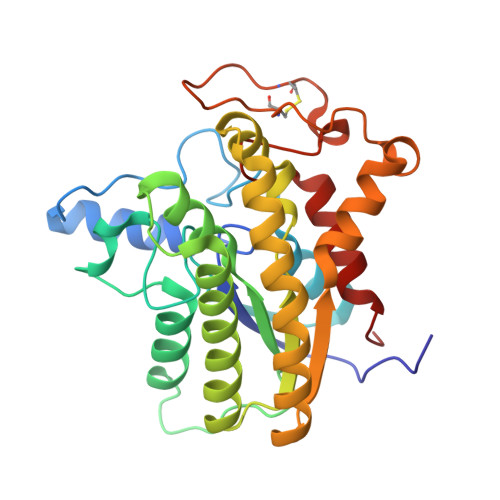Structural insights into the putative bacterial acetylcholinesterase ChoE and its substrate inhibition mechanism.
Pham, V.D., To, T.A., Gagne-Thivierge, C., Couture, M., Lague, P., Yao, D., Picard, M.E., Lortie, L.A., Attere, S.A., Zhu, X., Levesque, R.C., Charette, S.J., Shi, R.(2020) J Biol Chem 295: 8708-8724
- PubMed: 32371400
- DOI: https://doi.org/10.1074/jbc.RA119.011809
- Primary Citation of Related Structures:
6UQV, 6UQW, 6UQX, 6UQY, 6UQZ, 6UR0, 6UR1 - PubMed Abstract:
Mammalian acetylcholinesterase (AChE) is well-studied, being important in both cholinergic brain synapses and the peripheral nervous systems and also a key drug target for many diseases. In contrast, little is known about the structures and molecular mechanism of prokaryotic acetylcholinesterases. We report here the structural and biochemical characterization of ChoE, a putative bacterial acetylcholinesterase from Pseudomonas aeruginosa Analysis of WT and mutant strains indicated that ChoE is indispensable for P. aeruginosa growth with acetylcholine as the sole carbon and nitrogen source. The crystal structure of ChoE at 1.35 ? resolution revealed that this enzyme adopts a typical fold of the SGNH hydrolase family. Although ChoE and eukaryotic AChEs catalyze the same reaction, their overall structures bear no similarities constituting an interesting example of convergent evolution. Among Ser-38, Asp-285, and His-288 of the catalytic triad residues, only Asp-285 was not essential for ChoE activity. Combined with kinetic analyses of WT and mutant proteins, multiple crystal structures of ChoE complexed with substrates, products, or reaction intermediate revealed the structural determinants for substrate recognition, snapshots of the various catalytic steps, and the molecular basis of substrate inhibition at high substrate concentrations. Our results indicate that substrate inhibition in ChoE is due to acetate release being blocked by the binding of a substrate molecule in a nonproductive mode. Because of the distinct overall folds and significant differences of the active site between ChoE and eukaryotic AChEs, these structures will serve as a prototype for other prokaryotic acetylcholinesterases.
Organizational Affiliation:
D¨¦partement de Biochimie, de Microbiologie et de Bio-informatique, Universit¨¦ Laval, Qu¨¦bec, Canada; Institut de Biologie Int¨¦grative et des Syst¨¨mes (IBIS), Universit¨¦ Laval, Qu¨¦bec, Canada; PROTEO, the Qu¨¦bec Network for Research on Protein Function, Engineering, and Applications, Qu¨¦bec, Canada.
















